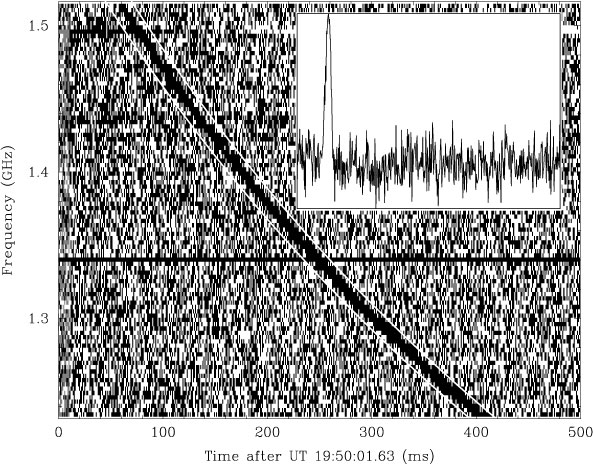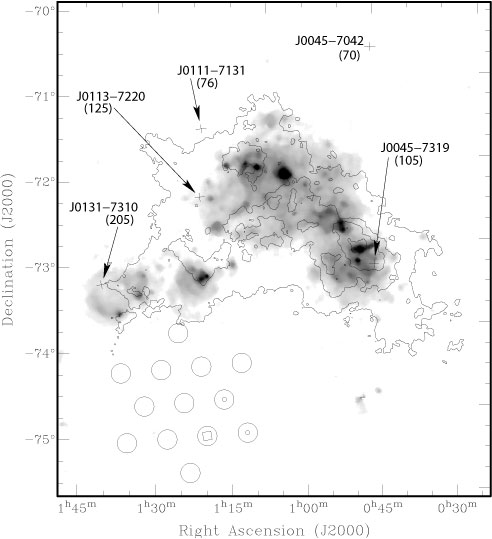A bright millisecond radio burst of extragalactic origin
Duncan Lorimer (West Virginia University, USA), Matthew Bailes (Swinburne University), Maura McLaughlin (West Virgina University, USA), David Narkevic (West Virginia University, USA) and Fronefield Crawford (Franklin & Marshall College, USA)
Transient radio sources are difficult to detect, but can potentially provide insights into a wide variety of astrophysical phenomena. Radio pulsar surveys offer one of the few opportunities to monitor even a small fraction (~10-5) of the radio sky for impulsive burst-like events with millisecond durations. Motivated by the recent discovery of rotating radio transients (neutron stars which exhibit only occasional sporadic bursts of emission) in the Parkes multibeam pulsar survey data, a team led by Duncan Lorimer at West Virginia University has been searching for transient events in a recent Parkes survey of the Magellanic Clouds. The raw data are de-dispersed to produce times series at multiple trial dispersion measures. For each time series, events which exceed six times the local standard deviation are saved for visual inspection. A highly significant signal with a peak flux of 30 Jy shown in Figure 1 was found by student David Narkevic in late 2006. The burst was so strong that it saturated the digitizers and was detected in three out of the 13 beams of the multibeam system!

Figure 1: Frequency evolution and integrated pulse shape of the radio burst shown as a two-dimensional “waterfall plot” of intensity as a function of radio frequency versus time. Pulse dispersion is clearly seen as a quadratic sweep across the frequency band, with broadening towards lower frequencies due to scattering. The two white lines separated by 15 ms that bound the pulse show the expected behavior for the cold-plasma dispersion law. Inset: the total-power signal after a dispersive delay correction. The time axis on the inner figure also spans the range 0 – 500 ms.
Due to the anomalously high amount of dispersion, it is highly unlikely that the burst is associated with our Galaxy or the Small Magellanic Cloud, located three degrees away on the sky (Figure 2). No counterparts have been found at other wavelengths and the source has not been observed to repeat, despite an intensive 40-hour observing campaign in April 2007 led by Matthew Bailes. The lack of an optical counterpart to the burst implies that it is at least 600 Mpc distant. Using models of intergalactic dispersion, the delay we observe in Figure 1 is consistent with a cosmological event up to 1 Gpc away. The source therefore appears to represent the first millisecond radio burst ever detected from outside our Galaxy.
>

Figure 2: Multi-wavelength image of the field surrounding the burst. The grey scale and contours respectively show Hα and HI emission associated with the Small Magellanic Cloud. Crosses mark the positions of the five known radio pulsars in the Small Magellanic Cloud. Open circles show the positions of the 13 beams in the original survey pointing, with squares showing the beams in which we detected the burst.
The origin of the source is currently unclear. The energy release and brightness temperature of such a source at 1 Gpc would be ~ 4 x 1040 erg and ~ 1034 K, respectively. Light-travel-time arguments limit the source size to <1500 km. These results imply, for a non-relativistic source, a coherent emission process from a compact region. Possible scenarios are that we are seeing the radio counterpart of a gamma-ray burst, or the radio signatures of a coalescing neutron star binary. One recent paper (Popov & Postnov 2007, astro-ph/0710.2006) posits that the burst could be a hyperflare from a magnetar (a neutron star with a 1014 - 1015 G magnetic field).
A key implication of the new discovery is that many hundreds of similar bursts should be detectable each day, but the small field of view and limited temporal and spectral resolution of most radio telescopes has thus far rendered them largely invisible.
We are currently searching archival data sets for further examples, and a team led by Matthew Bailes is using the Parkes telescope to monitor the sky in this mode by piggybacking on other observations.
Perhaps the most intriguing feature of this burst is its 30 Jy strength. While this has allowed us to make a convincing case for its extraterrestrial nature, the fact that it is over 100 times our detection threshold makes its uniqueness puzzling. Often, astronomical sources have a flux distribution that would naturally lead to many burst detections of lower significance; such events are not observed in our data. If, on the other hand, this burst was a rare standard candle, more distant sources would have such large dispersion measures that they would be both significantly red-shifted to lower radio frequencies and outside our attempted dispersion trials. If redshifts of their host galaxies are measurable, the potential of a population of radio bursts at cosmological distances to probe the ionized intergalactic medium is very exciting, especially given the construction of wide-field instruments in preparation for the Square Kilometre Array.
